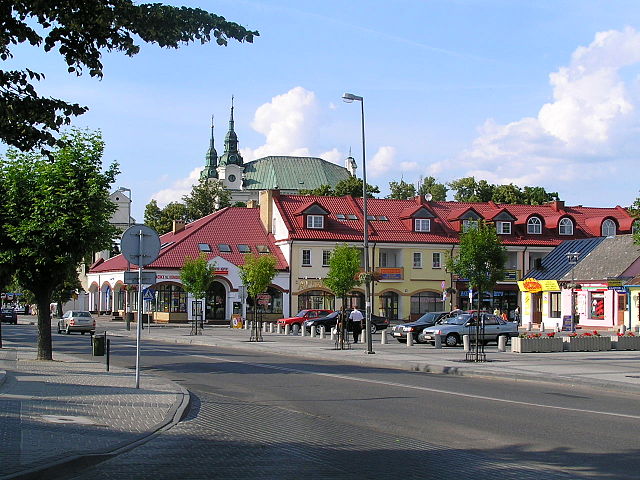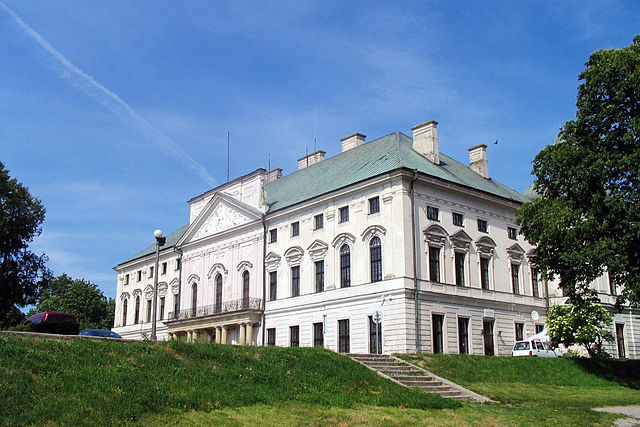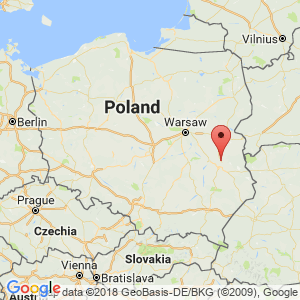Lubartów

Center in the city of Lubartów.- Photo by: No machine-readable author provided. Yarek shalom assumed (based on copyright claims)., Lubartow lubelskie center miasta 03, CC BY-SA 3.0
Distance
Population
22.654 (2010)
Location and history
Lubartów is located in eastern Poland, north of the county capital of Lublin.
The town's history goes back to the 16th century. On May 29, 1543, Piotr Firlej, voyage of Lublin, received a privilege from King Zygmunt the Old, who granted him permission to found the city of Lewartów. The name refers to the genus Firlej’s weapons containing a leopard. The town name was slightly distorted over time and in 1744 the name was officially changed to Lubartów.
In the northern part of town, Firlej built his bourgeois mansion, with a beautiful garden around. Not far from there a wooden church was erected. The city's next owner, Piotr Firlej’s son, Mikołaj Firlej, became very important for the development of the city. Among other things. he summoned artisans and cattle breeders from the Netherlands, Flanders and Germany, and gave permission for the creation of artisan guilds for shoemakers, tailors, bundlers and weavers.
The 17th year. was a recession for the city, so it was destroyed during the Swedish wars.
In the 18th century. it went forward again; under Paweł Sanguszko’s ownership was built in 1733-38 St. Anna's Church on the site of the former wooden church, as well as providing funds for the building of the Capuchin Order monastery and church.
In 1744, King August III reaffirmed the city's marketplace rights and changed the city name to Lubartów.
After Poland's third division in 1795, Lubartów came under Austrian rule, but in 1815 the city came under Russia. During World War I, the city was occupied by Austria from 1915 until 1918.
After Poland regained its independence, Lubartów had to struggle for a long time to rid himself of the consequences of years of repression and decline. The industry developed strongly. The city's masons were known for their skill and erected buildings not only in the city itself, but throughout Poland and in several Russian cities.
During World War II, there was a strong resistance movement in Lubartów. In 1939, Jews made up over 50% of the population; in 1942 the Germans brought Lubartów’s Jewish population to the extermination camps in Bełżec and Sobibor. To the liberation of the city on July 22, 1944, the local branch of Armia Krajowa (Home Army) contributed greatly.
One of the largest industrial companies in today's Lubartów is Roto, which produces windows and doors, but specializes in skylights and ceiling stairs. Another big company is the packaging company Stella Pack, which among other things manufactures garbage bags. – In Lubartów there is a distribution center for the well-known supermarket chain Biedronka.
Tourist attractions
Selected attractions:
Sanguszko Mansion
Piotr Firlej, who also founded the city, built a castle here in the 16th century. The castle had different owners and in the second half of the 17th century. the building was converted into a castle. For many years (from the beginning of the 18th century until 1839), the castle was owned by the Sanguszko family, who were also the town's owners. The first Sanguszko to own the castle was Lithuanian Grand Marshal Pawel Sanguszko (Pavilas Sanguška). A castle belongs to the castle.

Sanguszko Palace. – Photo by: Czarnecki Radosław, Lubartów, Pałac-Sanguszków, CC BY-SA 3.0
St. Anna's Church
from 1735-1738. There is also a Parish Museum here.
The Abbey of the Capuchin Order
built in the middle of the 18th century, includes the monastery, the church and the monastery.
The Jewish cemetery
brought in the year 1600.
regional Gallery
furnished in a distinguished house from the 19th century. The museum is now organized as a section of the Lublin Museum.
Surrounding Area
Kozłówka
In the village of Kozlowka west of Lubartów you can visit the Zamoyski Museum, which is housed in the beautiful mansion from the 18th century. The first mention of the castle dates from 1742. From 1799-1800 and from 1836-1944 the property belonged to the genus Zamoyski. The main building is flanked by two high towers and behind the building you can see the castle park. In the museum you can see the castle's various rooms and their decor as well as exhibitions with painting, sculpture and crafts.
River Wieprz
The river (which is a tributary to Wisła) flows past Lubartów’s eastern outskirts in the south-north direction. Wieprz is the 9th longest river in Poland.
Firlej Lake
12 km northwest of Lubartow lies Lake Firlej with several tourist facilities.
Bicyclerute
If tourists want to get to know the area better, then you can get no less than 18 suggestions for cycling routes based in Lubartów by contacting the tourist office.
landscape Park
South of Lubartów lies the landscape park “Kozłowiecki Park Krajobrazowy”.
Accommodation
Booking.com
Lubartów – with practical information for tourists
Eating Out:
Lubartów – with practical information for tourists
Other Internet sites and sources
Translated into English by Google Translate. Spangshus.dk accept no liability for any errors or omissions in translation.
Map

Rating
Search
Most used tags
churches (205) Castles (86) Monasteries (79) Town walls (74) Lakes (71) Town halls (67) Rivers (65) Castles1 (62) Mansions (55) Museums (51) Regional museums (38) Town gates (36) Abbey churches (35) Castle ruins (30) Cathedrals (26) Forests (25) Health resorts (24) Mounds (23) Water sports (23) National parks (22)Click for all tags
Denne side er også tilgængelig på dansk. This page and contents is (c) Copyright 2018- www.spangshus.dk. Based on Inviator software by ISCA Software